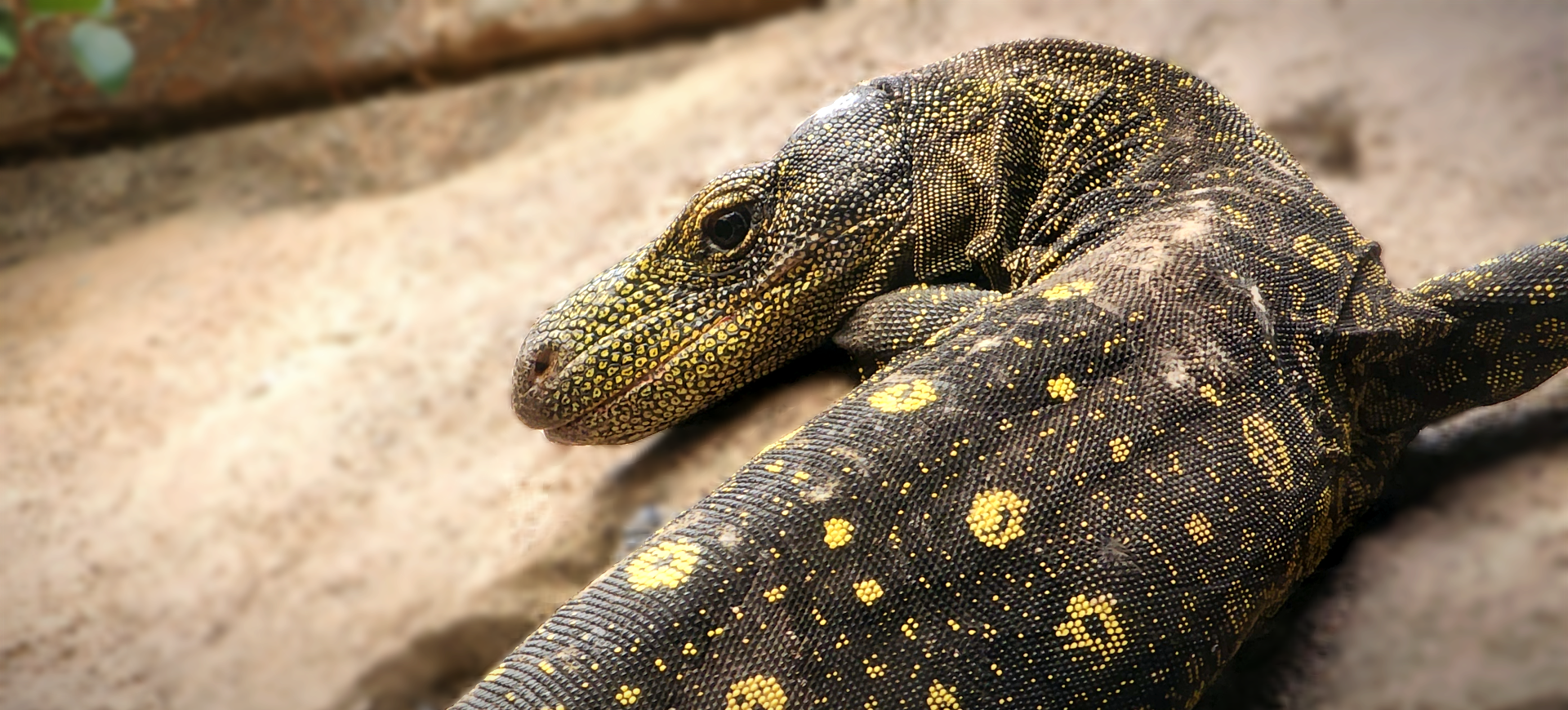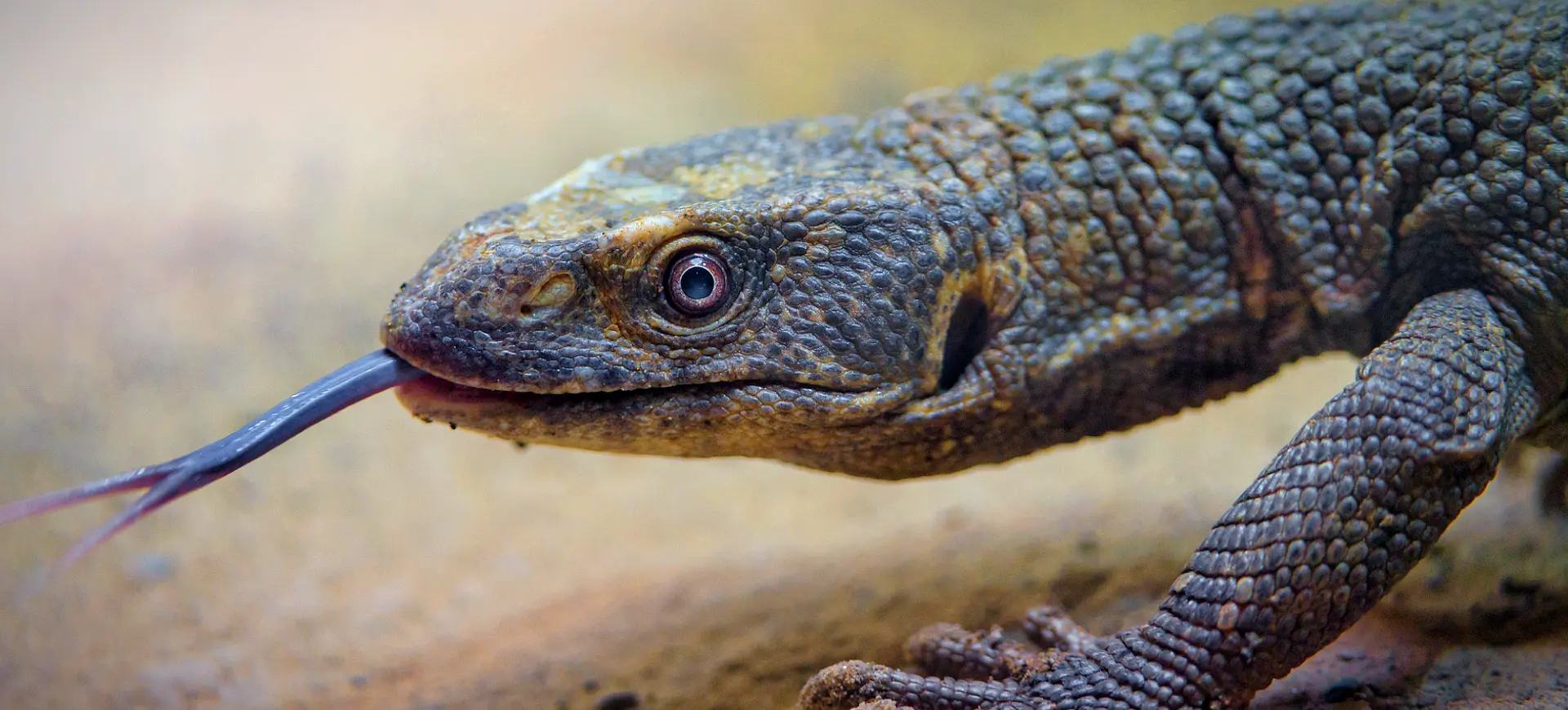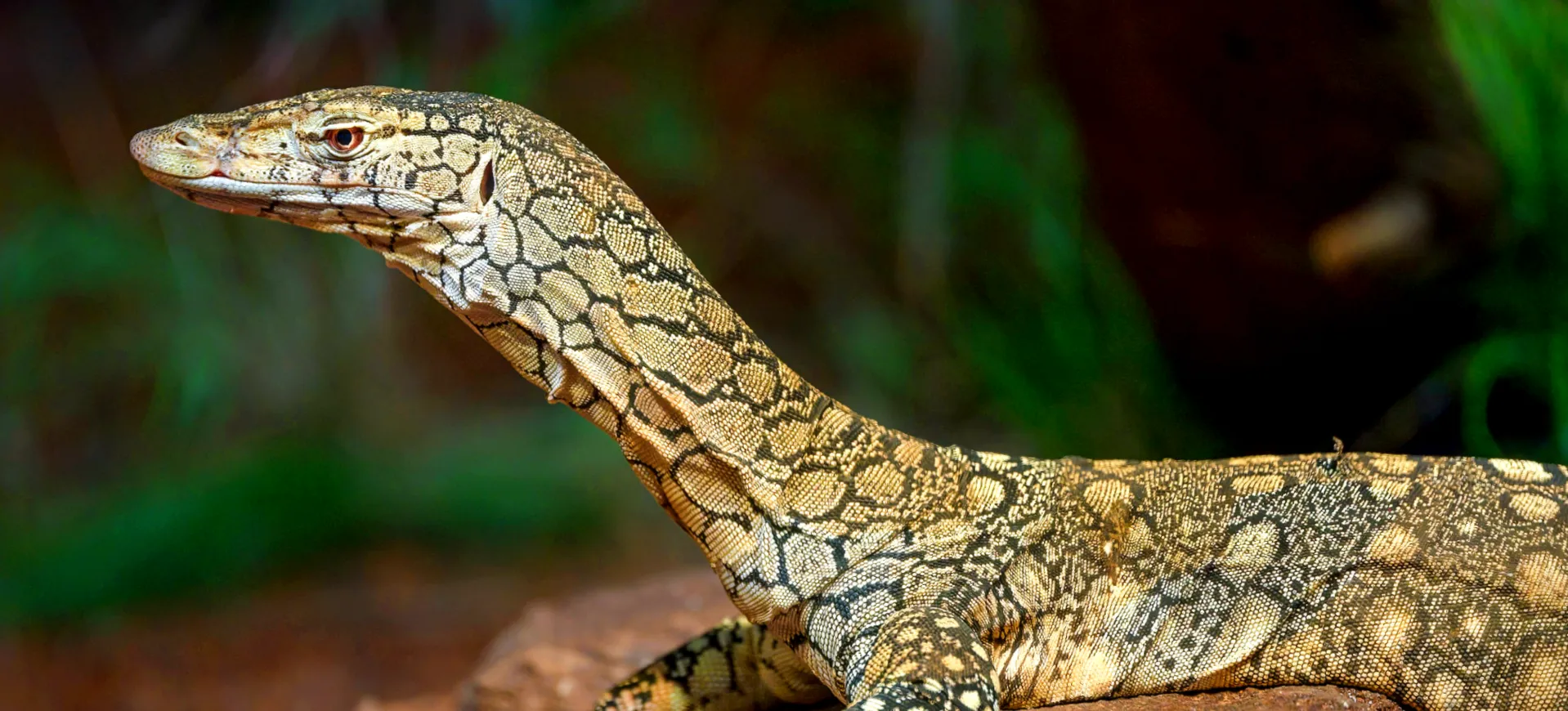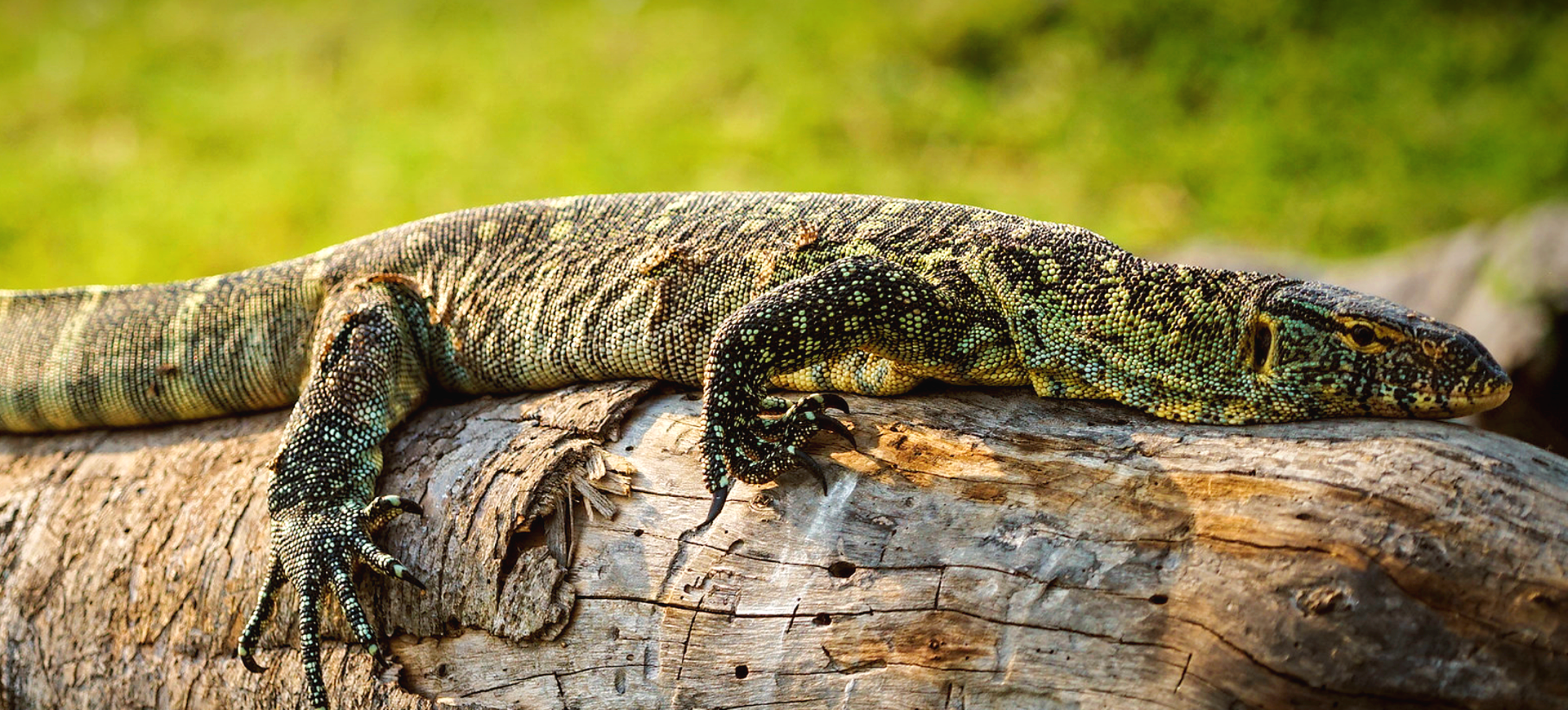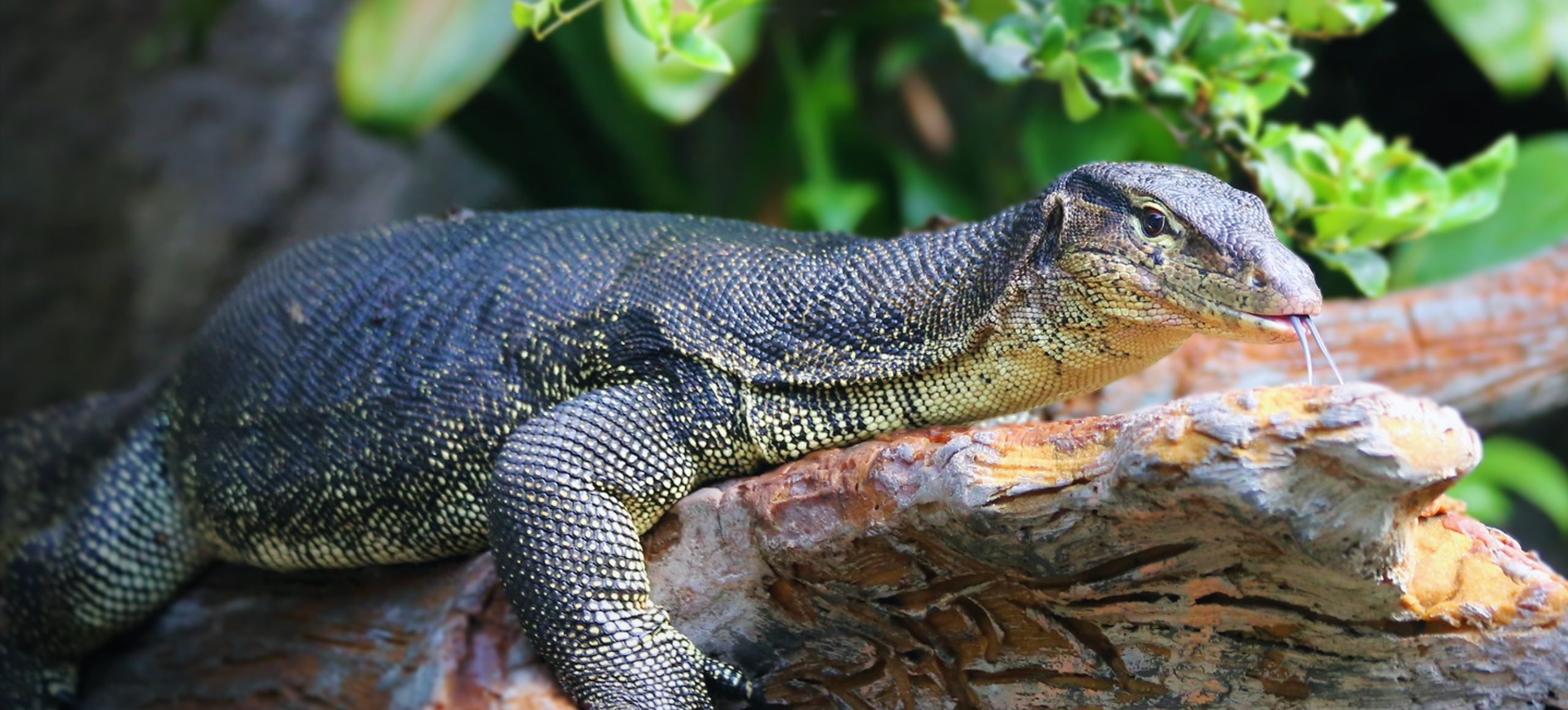Overview
The Komodo dragon, also known as the Komodo monitor, is the largest living species of lizard, known for its powerful physique, fearsome appearance, and robust survival skills. Found primarily on the Indonesian islands of Komodo, Rinca, Flores, and Gili Motang, these formidable creatures have attracted scientific curiosity and popular fascination due to their significant size, unique behaviors, and distinctive ecological roles. They possess long, flat heads with a rounded snout, scaly skin, bowed legs, and a large, muscular tail.
An adult Komodo dragon’s body can reach lengths of up to 10 feet and weigh up to 200 pounds, making them an apex predator in their environment. The Komodo dragon’s skin is reinforced by armored scales containing tiny bones forming a natural chain-mail. This tough and flexible hide offers considerable protection against the attacks of other Komodo dragons. The color of the dragons can range from dark grey to brick red, while juveniles are more colorful, with a combination of yellow, green, and white bands.
Komodo dragons are not only powerful hunters but are also equipped with a keen sense of smell. They utilize their long, yellow, deeply-forked tongue to sample the air, after which the tongue is retracted, and its tips are inserted into the roof of the mouth, where there are special sensory cells. The dragons can identify the direction of a particular scent, enabling them to locate carrion from several kilometers away.
Physical Description:
Komodo Dragons are massive, with adult males reaching lengths of up to 10 feet (3 meters) and weighing about 154 lbs (70 kg). Females are slightly smaller, often reaching around 8 feet (2.5 meters) and weighing around 110 lbs (50 kg). Their muscular tails are as long as their bodies, and their skin is reinforced with armored scales containing tiny bones known as osteoderms.
Their color ranges from gray to brick red, with younger dragons tending to have a more vibrant coloration than adults. Their long, yellow, deeply-forked tongues are one of their most distinctive features, which they use to sample the air, aiding their keen sense of smell. Their powerful, serrated jaws can deliver a powerful bite, and the venom glands located in their mouths can cause severe wounds.

Lifespan: Wild: ~30 years || Captivity: ~30 years

Weight: Male: 154 lbs (70 kg) || Female: 110 lbs (50 kg)

Length: Male: Up to 10 ft (3 m) || Female: Up to 8 ft (2.5 m)

Top Speed: 12 mph (19 km/h)
Characteristic:
Native Habitat:
Komodo Dragons are native to a few volcanic islands of the Lesser Sunda group of the Indonesian Archipelago, including Komodo, Rinca, Flores, and Gili Motang. They inhabit hot, arid areas with savanna-like conditions and prefer open lowland areas with tall grasses and bushes.
Despite their size, they are adept climbers and often climb trees and cliffs for food and to bask in the sun. They also utilize burrows dug by other animals or dig their own for rest and protection from extreme weather conditions.
Climate Zones:
Biomes:
Biogeographical Realms:
Continents:
Countries:
Diet:
Diet & Feeding Habits:
Komodo Dragons are carnivorous and capable of consuming large amounts of food at once due to their flexible jaws, enabling them to eat up to 80% of their body weight in a single feeding. Their diet consists primarily of carrion, but they also hunt and ambush live prey, including invertebrates, birds, and mammals.
Komodo Dragons use their forked tongues to pick up scent particles in the environment, helping them locate food. When a Komodo Dragon bites its prey, its venom hinders its ability to clot, leading to massive blood loss and shock, often resulting in the prey’s death.
Mating Behavior:
Mating Description:
Komodo Dragons breed between May and August, with males competing fiercely for access to females. They engage in wrestling matches, with the victor winning the right to mate with the female. After successful copulation, the female will lay up to 20 eggs in September, which she will bury in the sand or decomposing vegetation to keep them warm.
The eggs incubate for about eight months, and the hatchlings are independent of birth. Komodo females also can reproduce through parthenogenesis, a form of asexual reproduction where females can lay viable eggs without mating.
Reproduction Season:
Birth Type:
Pregnancy Duration:
Female Name:
Male Name:
Baby Name:
Social Structure Description:
Komodo dragons are solitary animals and only come together to breed and eat. They are not territorial but do establish loose home ranges that they patrol. During feeding, larger, dominant individuals eat first, with smaller ones waiting their turn. Conflict can occur, but it is typically limited to displays and occasional bites, with fatal fights being rare.
The social hierarchy among Komodo dragons is mainly determined by size. Larger individuals are dominant, and smaller ones are submissive. Even within the same sex, larger dragons are dominant. Males engage in ritual combat to access females during the breeding season, and the winner is usually the larger of the two.
Groups:
Conservation Status:
Population Trend:
The Komodo dragon population is estimated to be around 3,000 individuals in the wild. These populations mainly concentrate on Komodo, Rinca, Flores, and Gili Motang Islands. However, they are highly fragmented due to the island nature of their habitats. As the dragon’s natural range is restricted to a few islands within Komodo National Park, any environmental changes or disasters could devastate their numbers.
Despite being the top predators on their islands, Komodo dragons face threats from habitat loss, reduction in prey availability, and human activities. Tourism, while providing funds for conservation, can also disturb these creatures and their habitats. The population trend is decreasing due to these factors, coupled with their low reproductive rates and limited dispersal.
Population Threats:
The primary threats to Komodo dragons are habitat loss and degradation due to human activities. The establishment of human settlements, agricultural land conversion, and forest fires have significantly reduced their habitat. This has decreased prey availability, making it harder for the dragons to find food.
Illegal poaching of the dragons and their prey is another significant threat. Despite legal protection, Komodo dragons are still hunted for their skin and sometimes killed by villagers due to fear or retaliation for attacks on livestock. The increasing pressure from tourism also disturbs their habitats and can lead to increased stress and altered behavior in these animals.
Conservation Efforts:
Conservation efforts for the Komodo dragon are centered around habitat preservation and reducing human-wildlife conflict. The Komodo National Park was established to protect the dragon and its habitat. The park conducts various conservation activities, including population monitoring, habitat management, and research into the dragon’s ecology and behavior.
Education and awareness programs are also an integral part of conservation efforts. These programs aim to educate local communities and tourists about the importance of the Komodo dragon and the need for its conservation. Stricter laws and regulations have also been implemented to curb poaching and illegal trade in Komodo dragon parts.
Additional Resources:
Fun Facts
- Despite their size, Komodo Dragons are excellent swimmers and can swim from one island to another.
- The saliva of a Komodo Dragon contains over 50 strains of bacteria, which can lead to blood poisoning in a victim if a bite does not prove fatal.
- Female Komodo Dragons can reproduce without a male through a process called parthenogenesis.
- Juvenile Komodo Dragons have a different diet than adults, mainly feeding insects, birds, and eggs.
- Komodo Dragons have been known to dig up graves to eat the bodies, leading local people to place rocks over the graves to prevent this.
- The population of Komodo Dragons is the highest in Komodo National Park, a UNESCO World Heritage Site.
- They have a keen sense of smell and can detect carrion up to 9.5 kilometers away.
- When threatened, a Komodo Dragon can vomit its stomach contents to reduce weight and flee more quickly.
- Komodo Dragons can live up to 30 years in the wild and captivity.
- They are known as “ora” or “land crocodiles” by locals.






